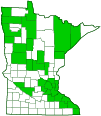blackberry looper
(Chlorochlamys chloroleucaria)
Conservation • Description • Habitat • Ecology • Distribution • Taxonomy
|
||||||||
| Hodges # | 7071 |
|||||||
Conservation Status |
||||||||
| IUCN Red List | not listed |
|||||||
| NatureServe | NNR - Unranked |
|||||||
| Minnesota | not listed |
|||||||
Description |
||
Blackberry looper is a small, widespread, and very common emerald moth. It occurs in the United States east of the Rocky Mountains, in adjacent Canadian provinces, and in Mexico. It is very common in Minnesota. It is found in woodlands, fields, and other open areas. There are two generations each year. Adults fly from May to September and mature caterpillars are found from May through fall. Adult blackberry looper moths have a wingspan of 9 ⁄16″ to ⅞″ (14 to 23 mm). There is a wide longitudinal stripe on the upper (dorsal) side of the thorax extending to the tip of the abdomen. The wings are relatively large and grayish-green with creamy white lines and with minute, creamy white speckling that gives them a grainy appearance. The forewing has wide antemedial (AM) and postmedial (PM) lines, a wide band on the leading (costal) margin, and sometimes a thin line on the outer margin (terminal line). The fringe is creamy white. The hindwing is similar but with only a PM line. As the adult ages the green fades and the wings become more cream colored. The antennae on the male are broadly feather-like with extensions along both sides of the shaft (bipectinate). On the female the antennae are thread-like. The caterpillar is less than 1″ (2.5 cm) long. The body is pale green with minute whitish speckling. The head is brownish. There are pale, slender horns on the head and first thoracic segment that project forward. There is a pale longitudinal stripe in the middle (middorsal stripe) and on each side there is one thin pale stripe in the subdorsal area, one above the breathing pores (spiracles), one through the spiracles, and one below the spiracles. There is also a yellow band between each abdominal segment. Mature caterpillars are active from May to fall. |
||
Size |
||
Wingspan: 9 ⁄16″ to ⅞″ (14 to 23 mm) |
||
Similar Species |
||
Habitat |
||
Woodlands, fields, and other open areas |
||
Ecology |
||
Season |
||
Two generations per year: May to September |
||
Behavior |
||
Adults are active both day and night. They sometimes come to lights but in small numbers. |
||
Life Cycle |
||
|
||
Larva Hosts |
||
Blackberry, raspberry, and strawberry fruits, and the flower petals of goldenrods and many other plants in the Aster (Asteraceae) family. |
||
Adult Food |
||
|
||
Distribution |
||||
|
Sources |
|||
| 12/25/2022 | ||||
Occurrence |
||||
Widespread and very common in Minnesota |
||||
Taxonomy |
|||
Order |
Lepidoptera (Butterflies and Moths) | ||
Superfamily |
Geometroidea (geometrid and swallowtail moths) | ||
Family |
Geometridae (geometer moths) | ||
Subfamily |
Geometrinae (emerald moths) | ||
Tribe |
Hemitheini | ||
Genus |
Chlorochlamys | ||
Synonyms |
|||
Aplodes flavilineata Eucrostis rectilinea Geometra desolataria Nemoria chloroleucaria Nemoria densaria Nemoria indiscriminata Thassodes deprivata |
|||
Common Names |
|||
blackberry looper blackberry looper moth |
|||
Glossary
Antemedial line
A thin line separating the basal area and the median area of the forewing of Lepidoptera.
Costal margin
The leading edge of the forewing of insects.
Spiracle
A small opening on the surface of an insect or arachnid through which it breathes.
Visitor Photos |
|||||
Share your photo of this insect. |
|||||
| This button not working for you? Simply email us at info@MinnesotaSeasons.com. Attach one or more photos and, if you like, a caption. |
|||||
Alfredo Colon |
|||||
 |
|||||
 |
 |
||||
MinnesotaSeasons.com Photos |
|||||
|
|||||

Visitor Videos |
|||
Share your video of this insect. |
|||
| This button not working for you? Simply email us at info@MinnesotaSeasons.com. Attach a video, a YouTube link, or a cloud storage link. |
|||
Other Videos |
|||
| Blackberry Looper Moth (Geometridae: Chlorochamys chloroleucaria) Dorsal view Carl Barrentine |
|||
About
Aug 16, 2011 Photographed at the Turtle River State Park, North Dakota (16 August 2011). Thank you to Maury Heiman (@Bugguide.net) for identifying this specimen! |
|||

Created: 11/23/2019
Last Updated:





